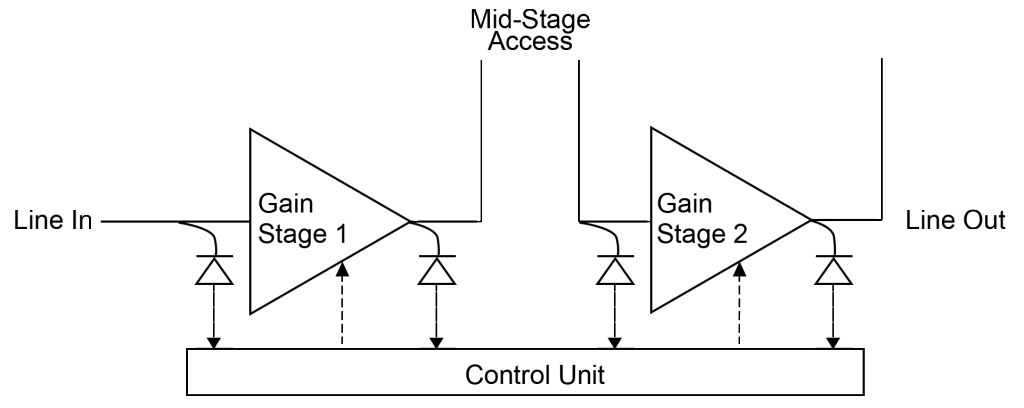Besides optical amplifiers, modern optical networks also require other components to be place along the link, such as the Dispersion Compensation Module (DCM) used to correct signal distortion due to Chromatic Dispersion of the transmission fiber. Since the attenuation of DCM can be quite large, in the range of 5 to 10 dB, additional amplification is needed to accommodate them. In order to minimize the Optical Signal Noise Ratio (OSNR) and cost impact of this addition amplification, it is beneficial to place the DCM between two amplifiers.
A dual stage EDFA amplifier is basically two amplifiers in one package, where there is access for an optical component such as a DCM to be placed between them. In this configuration, it is called a DCM-optimized EDFA. Most often the first amplifier (pre-amplifier) is variable gain, and the second (booster amplifier) is fixed gain, such that the amplifier as a whole provides variable gain operation. The control of both amplifiers is combined, in other words the user sets the required net gain of the entire combination (including the DCM), and the control units sets the gain of each of the two amplifier in order to achieve the net gain.
Note: DCM-optimized EDFA is named because of using DCM as the mid-stage access. The DCM EDFA can be generally provided as a stand-alone module or in a managed 1RU package with the DCM integrated within. Fiberstore’s Dual Stage DCM-optimized EDFA is a stand-alone module without the DCM which need to be bought separately. In this way, customers could choose the right dispersion compensation modules to meet their own requirements.


Here is the basic scheme for a dual stage EDFA amplifier with DCM mid-stage access. The two amplifiers are packaged in the same module and are controlled together with the mid-stage device (i.e. the DCM) as a single unit. Additionally, each amplifier also has its own local control loops.

The amplifiers are designed apriori to take into account the DCF loss. For example, the dynamic range of the input detectors of both amplifiers is set accordingly, and the optical performance, such as Noise Figure (NF), is specified already taking the DCM loss into account. Since the DCM is often implemented using special Dispersion Compensation Fiber (DCF), there can be a large optic al delay between the first and the second stage of the amplifier. For this reason transi ent suppression of each amplifier ne eds to be performed separately, and consequently each amplifier has its own pump and own local control mechanism (in addition to the overall control used to set the net gain).